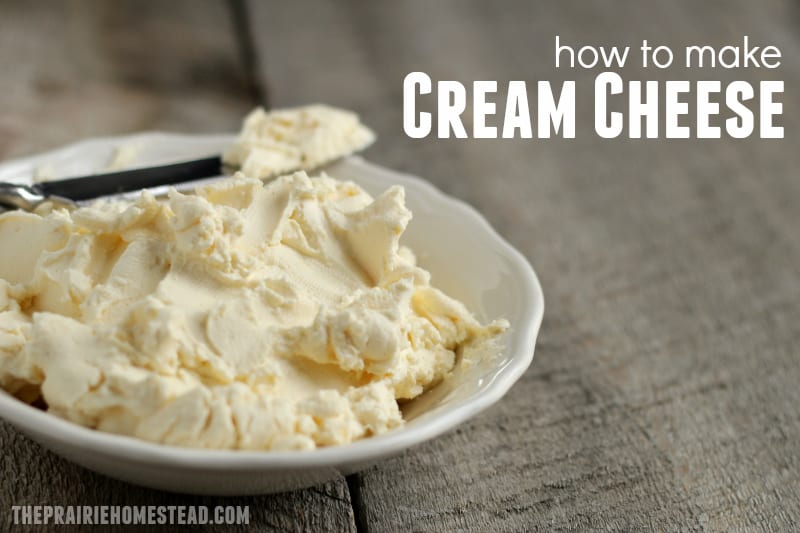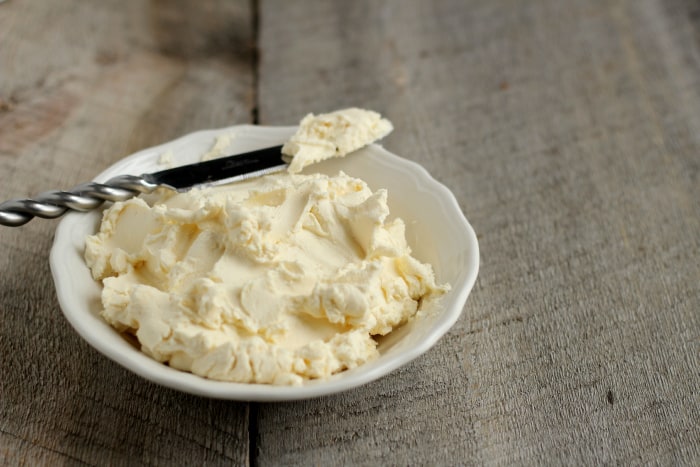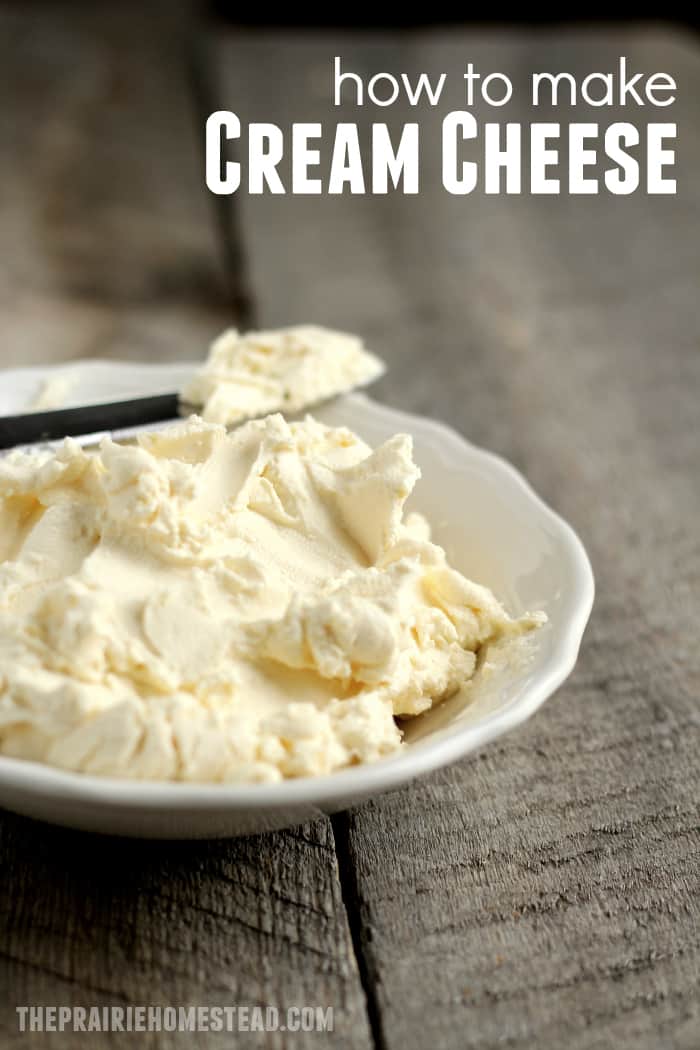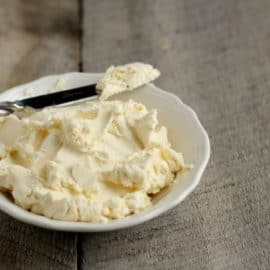Do Raw Milk Need to Rest Before Make Cheese
Learn how to make cream cheese with my super simple recipe. Homemade cream cheese is so delicious, you'll be eating it off a spoon. Here's what you need to know for your home dairy journey with making cream cheese.

Learning how to make cream cheese is one of those things that makes you feel like a homesteading rockstar…
But I have to warn you before you proceed, otherwise it just wouldn't be fair:
Homemade cream cheese is one of those things that beckons you to eat it in large spoonfuls. You've been warned.
Yeah, yeah… Smearing it on homemade bagels is nice too, but there's just something about eating it plain…
Since I am currently milking our cow twice daily and have an abundance of cream (for the first time in a looong time), I decided it was time to try playing around with making my own cream cheese.
And, let me just say that it couldn't be easier!
First, some clarifications on making homemade cream cheese…
Number 1: there seems to be about a million different methods if you want to learn how to make cream cheese… This is the method I prefer, and it's pretty darn simple.
Number 2: Many, MANY "cream cheese" recipes are actually yogurt cheese or fromage blanc recipes. I've made a lot of yogurt cheese as well, and it's great– but not the same as real cream cheese. The flavor and texture are notably different.
Number 3: I used my fresh, raw cream for this recipe. However, since you are adding a culture to it, you could use store-bought, pasteurized cream if you had to. Or even half & half would work. Just try to use the highest quality cream that you can find.

How to Make Cream Cheese
(This post contains affiliate links)
- 2 cups cream*
- 2 cups whole milk*
- 1 package cream cheese starter culture OR 1/8 teaspoon of Mesophilic starter culture (where to buy mesophilic culture)
- Fine cheesecloth (Find out how to improvise your own cheesecloth, or purchase cheesecloth here.)
- Sea salt to taste (optional, but I love this one)
*Select raw dairy or regular pasteurized dairy. Avoid ultra-heat treated (UHT) milk or cream, as it will yield inconsistent results.

Make sure you are using a glass container to hold your cream/milk. Gently stir in the starter culture.
Loosely cover (not airtight!) and set it on your counter top to culture for 8 to 12 hours. (It may take more or less time, depending on the temperature of your kitchen.)
You'll know it's done when it has set up and somewhat resembles yogurt. (It might not be a perfectly even consistency, but that's ok.)
Dump the thickened cream into the cheesecloth and allow the whey to drip out for at least 12 hours (the longer it drips, the firmer your finished cheese will be).
(Instead of draining the cream at this stage, you could also turn it into cultured butter. Decisions… decisions…)
You might have to get a little creative with your drip set-up. I don't have any knobs on my cabinet doors, so I tie the ends of my improvised cheesecloth around a wooden spoon and allow it to drip into a pitcher.

Once it has reached the desired consistency, scrape it out of the cheesecloth and lightly salt it to taste. The salt is optional, but it will help it keep slightly longer. Store in an airtight container in your fridge– it will get firmer as it chills.

I usually get 1 1/2 to 2 cups of cream cheese out of 1 quart of cream/milk. Yields will vary slightly.
Kitchen Notes:
- I've seen several recipes that use cultured buttermilk instead of the mesophilic culture to make cream cheese. I haven't personally tried it, but it would probably work just as well. Add 1/8 to 1/4 cup of buttermilk to your quart of cream to try this method.
- You can use all cream in this recipe for a richer result, or all milk for a less-rich cream cheese. The choice is yours.
- You can spice up your cream cheese with all sorts of different flavors! Mix in cinnamon, fruit preserves, or even some chives and onion powder for a unique treat.
- To make yogurt cheese: Follow this exact same method, substituting the quart of cultured cream with a quart of yogurt (homemade yogurt or store bought) instead.
- Here are a bunch of ways to use the leftover whey. Getting fresh whey is one of the perks of learning how to make cream cheese– don't waste it!
- If you *ahem* accidentally forget about your cream cheese and leave it culturing or dripping for longer than stated above, don't sweat it. It won't hurt it and the worse that will happen is that it will just be slightly tangier.
- I love New England Cheese Making Supply Co. for all of my cheese making needs. They're a great, family-owned company, not to mention their superior products that haven't failed me yet. While you can stock up on cheese making supplies from places like Amazon, it's a great idea to only buy cultures and starters from reputable companies to prevent frustrating attempts at making cheeses with poor-quality cultures.
Let me just say that homemade cream cheese is infinitely better than the store bought stuff. You'll want to scoop it out of the container and eat it plain… Or smear it on some chocolate zucchini bread… Or homemade bagels… Or make a pumpkin cheesecake… Or….

How to Make Cream Cheese

- Yield: 1 1/2 to 2 cups of cream cheese 1x
Instructions
- Use a glass container to hold your cream/milk and gently stir in the starter culture
- Loosely cover (not airtight!)
- Leave on countertop 8 to 12 hours to culture, time varies depending on temperature
- It's ready when it somewhat resembles yogurt
- Dump thickened cream into cheesecloth and allow whey to drip out at least 12 hours (the longer it drips, the firmer your cheese will be)
- Scrape out of cheesecloth and lightly salt to taste (salt is optional, but it lasts longer)
- Store in an airtight container in fridge
Notes
It gets firmer as it chills
Want to learn how to make from-scratch recipes in your kitchen without taking lots of time? I've got videos, recipes, and tips for you in my Heritage Cooking Crash Course. Check it out!
More Home Dairy Tips and Recipes:
- 3 Home Dairy Myths
- How to Make Ricotta Cheese
- How to Make Homemade Mozzarella Cheese
- How to Make Fromage Blanc Soft Cheese
- How to Make Butter
- How to Make Sour Cream

Learn to Cook Like a Farmer!
Get my best tips & recipes for transforming your kitchen into a farmstyle kitchen, no matter where you live! Enter your best email for instant access>>
Do Raw Milk Need to Rest Before Make Cheese
Source: https://www.theprairiehomestead.com/2012/10/how-to-make-cream-cheese.html